Commissioner of Central Excise Ambalal Sarabhai Enterprises Ltd.
Commissioner of Central Excise Ambalal Sarabhai Enterprises Ltd.
Commissioner of Central Excise Ambalal Sarabhai Enterprises Ltd.
Create successful ePaper yourself
Turn your PDF publications into a flip-book with our unique Google optimized e-Paper software.
VATLaws (Readable Version) - Wednesday, June 26, 2013<br />
[2013] 57 VST 21 (Guj)<br />
[IN THE GUJARAT HIGH COURT]<br />
<strong>Commissioner</strong> <strong>of</strong> <strong>Central</strong> <strong>Excise</strong><br />
<strong>Ambalal</strong> <strong>Sarabhai</strong> <strong>Enterprises</strong> <strong>Ltd</strong>.<br />
V.<br />
AKIL KURESHI AND SONIA GOKANI (MS) , JJ.<br />
April 21, 2011<br />
HF ♦ Assessee, including dealer (Registered or Unregistered)<br />
SERVICE TAX--CENVAT CREDIT--INPUT SERVICE--DEFINITION--COURIER SERVICE USED BY<br />
MANUFACTURER FOR TRANSPORTATION OF FINISHED GOODS FROM FACTORY AND BRINGING<br />
INPUTS INTO FACTORY--IS INPUT SERVICE--SERVICE TAX PAID THEREON CAN BE AVAILED OF AS<br />
CENVAT CREDIT--CENVAT CREDIT RULES, 2004, R. 2(L).<br />
Courier service utilised by a manufacturer for transportation <strong>of</strong> finished goods from the factory and bringing<br />
inputs into the factory are covered within the expression “any service used by the manufacturer directly or<br />
indirectly in or in relation to the manufacture <strong>of</strong> final products and clearance <strong>of</strong> final products from the place <strong>of</strong><br />
removal” in the definition <strong>of</strong> “input service” under rule 2(l) <strong>of</strong> the Cenvat Credit Rules, 2004 and therefore<br />
service tax paid on courier services by the manufacturer was eligible for Cenvat credit.<br />
CCE and Customs v. Parth Poly Wooven P. <strong>Ltd</strong>. [2012] 47 VST 305 (Guj); [2012] 12 GSTR 419 (Guj) followed.<br />
Order <strong>of</strong> the Customs, <strong>Excise</strong> and Service Tax Appellate Tribunal affirmed.<br />
CCE and Customs v. Parth Poly Wooven P. <strong>Ltd</strong>. [2012] 47 VST 305 (Guj); [2012] 12 GSTR 419 (Guj) (paras 5,<br />
6, 7) and ABB <strong>Ltd</strong>. v. CCE and Service Tax [2009] 92 RLT 665 (Trib.-Mum) [LB] (para 3) referred to.<br />
Tax Appeal No. 433 <strong>of</strong> 2010 decided on April 21, 2011<br />
Y.N. Ravani for the appellant<br />
Dhaval Shah for the respondent<br />
Cases referred to :<br />
CCE and Customs v. Parth Poly Wooven P. <strong>Ltd</strong>. [2012] 47 VST 305 [2012] 12 GSTR 419 (Guj)<br />
followed<br />
CCE and Customs v. Parth Poly Wooven P. <strong>Ltd</strong>. [2012] 47 VST 305 [2012] 12 GSTR 419 (Guj)<br />
referred to<br />
ABB <strong>Ltd</strong>. v. CCE and Service Tax [2009] 92 RLT 665 (Trib.-Mum) [LB] referred to<br />
--------------------------------------------------<br />
JUDGMENT 1<br />
The judgment <strong>of</strong> the court was delivered by<br />
AKIL KURESHI J.-The Revenue is in appeal against the judgment <strong>of</strong> the<br />
This copy was printed from VATLaws licensed to: R.S. Goyal
VATLaws (Readable Version) - Wednesday, June 26, 2013<br />
Customs, <strong>Excise</strong> and Service Tax Appellate Tribunal dated July 22, 2009<br />
raising the following questions for our consideration:<br />
"(i) Whether the CESTAT was right in considering the service,<br />
namely, outward transportation in respect <strong>of</strong> courier service and<br />
clearing agents, availed <strong>of</strong> by the assessee, as eligible services for<br />
availing <strong>of</strong> input service credit as defined under rule 2(l) <strong>of</strong> the Cenvat<br />
Credit Rules, 2004?<br />
(ii) Whether the Tribunal committed an error in overlooking the<br />
definition <strong>of</strong> 'place <strong>of</strong> removal' prescribed under rule 4(3)(c) <strong>of</strong> the<br />
Cenvat Credit Rules, 2004, more particularly when goods are cleared<br />
by the assessee from the place <strong>of</strong> manufacturing after payment <strong>of</strong><br />
duty?"<br />
The short facts are as follows. The respondent-assessee had claimed<br />
Cenvat credit on service tax paid on the courier service provided by various<br />
courier agencies. Service <strong>of</strong> such courier agencies were utilised for transportation<br />
<strong>of</strong> finished goods from the factory and also for bringing inputs<br />
into the factory. These facts emerge clearly from the order-in-original<br />
passed by the adjudicating <strong>of</strong>ficer in his order dated July 31, 2008, the relevant<br />
portion <strong>of</strong> which reads as under:<br />
"2. On scrutiny <strong>of</strong> E.R.-I returns for the period from January, 2007<br />
to December, 2007, it was noticed that the assessee has taken service<br />
tax credit on courier services paid to courier service providers, namely,<br />
M/s. XPS couriers, M/s. Gati couriers and SAFEX Express (P) <strong>Ltd</strong>.,<br />
Ab'ad and clearing agent, namely, Gujarat State Export Corporation<br />
and UTI Worldwide Export Corporation. The said courier service providers<br />
and clearing agents took delivery <strong>of</strong> the finished goods from<br />
the factory and the inputs into the factory. The service tax on courier<br />
1 Oral.<br />
Page No: 22<br />
services paid to the clearing agents and courier service providers is<br />
not admissible as per rule 2(l) <strong>of</strong> the Cenvat Credit Rules, 2004.<br />
Therefore, service tax paid on courier services and clearing agents <strong>of</strong><br />
the goods is not eligible for availment <strong>of</strong> Cenvat credit. The said<br />
assessee had taken credit <strong>of</strong> service tax <strong>of</strong> Rs. 75,727, Rs. 1,545 as<br />
education cess and secondary higher education cess <strong>of</strong> Rs. 613 on<br />
courier services and clearing agent as per details provided by the<br />
assessee on service tax appears to be recoverable along with interest."<br />
The adjudicating <strong>of</strong>ficer was <strong>of</strong> the opinion that the assessee was not<br />
entitled to avail <strong>of</strong> such credit. He therefore, after issuance <strong>of</strong> show-cause<br />
notice and hearing the respondents passed an order dated July 31, 2008.<br />
The assessee challenged the order before the appellate authority. The<br />
<strong>Commissioner</strong> (Appeals), by his order dated March 17, 2009, dismissed the<br />
appeal upon which the assessee approached the Tribunal. The Tribunal by<br />
way <strong>of</strong> the impugned order dated July 22, 2009 allowed the appeal relying<br />
on the decision <strong>of</strong> the larger Bench <strong>of</strong> the Tribunal in the case <strong>of</strong> ABB <strong>Ltd</strong>.<br />
v. CCE and Service Tax reported in [2009] 92 RLT 665 (Trib.-Mum) [LB].<br />
Thereupon, the Revenue has approached this court in the present tax<br />
appeal.<br />
This copy was printed from VATLaws licensed to: R.S. Goyal
VATLaws (Readable Version) - Wednesday, June 26, 2013<br />
From the facts on record, it clearly emerges that the assessee had transported<br />
its goods from the factory through courier service. On service tax<br />
paid on such courier service, the assessee seeks Cenvat credit. The entire<br />
issue revolves around the definition <strong>of</strong> "input service" contained in rule 2(l)<br />
<strong>of</strong> the Cenvat Credit Rules, 2004. Rule 2(l) reads as under:<br />
"(l) 'input service' means any service,-<br />
(i) used by a provider <strong>of</strong> taxable service for providing an output<br />
service; or<br />
(ii) used by the manufacturer, whether directly or indirectly, in or<br />
in relation to the manufacture <strong>of</strong> final products and clearance <strong>of</strong> final<br />
products up to the place <strong>of</strong> removal,<br />
and includes services used in relation to setting up, modernisation,<br />
renovation or repairs <strong>of</strong> a factory, premises <strong>of</strong> provider <strong>of</strong> output<br />
service or an <strong>of</strong>fice relating to such factory or premises, advertisement<br />
or sales promotion, market research, storage up to the place <strong>of</strong><br />
removal, procurement <strong>of</strong> inputs, activities relating to business, such as<br />
accounting, auditing, financing, recruitment and quality control,<br />
coaching and training, computer networking, credit rating, share<br />
registry, and security, inward transportation <strong>of</strong> inputs or capital goods<br />
and outward transportation up to the place <strong>of</strong> removal;"<br />
Page No: 23<br />
Issue <strong>of</strong> similar nature came up before this court in Tax Appeal No. 419/<br />
2010 (CCE and Customs v. Parth Poly Wooven P. <strong>Ltd</strong>. [2012] 47 VST 305<br />
(Guj); [2012] 12 GSTR 419 (Guj)), wherein the assessees were claiming<br />
credit <strong>of</strong> service tax paid on the goods transport agency ("GTA" for short)<br />
service on outward transportation <strong>of</strong> the goods beyond the place <strong>of</strong><br />
removal relying on rule 2(l) <strong>of</strong> the Cenvat Credit Rules, 2004. This Bench<br />
framed the question in the following manner (page 422 <strong>of</strong> 12 GSTR):<br />
"Whether, in the facts <strong>of</strong> the case, the Tribunal was justified in<br />
holding that the assessee was entitled to avail <strong>of</strong> Cenvat credit on the<br />
service tax paid on GTA service on outward transportation <strong>of</strong> the<br />
goods beyond the place <strong>of</strong> removal in view <strong>of</strong> definition contained in<br />
rule 2(l) <strong>of</strong> the Cenvat Credit Rules, 2004 defining the term 'input<br />
service'?"<br />
This court by the judgement dated April 6, 2011 (CCE and Customs v.<br />
Parth Poly Wooven P. <strong>Ltd</strong>. [2012] 47 VST 305 (Guj); [2012] 12 GSTR 419<br />
(Guj)), after considering the statutory provisions applicable and series <strong>of</strong><br />
decisions cited, answered the question in favour <strong>of</strong> the assessee and<br />
against the Revenue. The Tribunal's judgment was confirmed. The tax<br />
appeals were dismissed. Reliance was placed on the definition <strong>of</strong> "input<br />
service" contained in rule 2(l) <strong>of</strong> the Cenvat Credit Rules, 2004 which was<br />
interpreted to be expansive in nature. It was observed as under (pages 320<br />
and 321 <strong>of</strong> 47 VST):<br />
"Bearing in mind the above judicial pronouncements, if we revert<br />
back to the definition <strong>of</strong> the term 'input service', as already noticed, it<br />
is coined in the phraseology <strong>of</strong> 'means and includes'. Portion <strong>of</strong> the<br />
definition which goes with the expression means, is any service used<br />
by the manufacturer whether directly or indirectly in or in relation to<br />
the manufacture <strong>of</strong> final products and clearance <strong>of</strong> final products from<br />
This copy was printed from VATLaws licensed to: R.S. Goyal
VATLaws (Readable Version) - Wednesday, June 26, 2013<br />
the place <strong>of</strong> removal. This definition itself is wide in its expression and<br />
includes large number <strong>of</strong> services used by the manufacturer. Such<br />
service may have been used either directly or even indirectly. To qualify<br />
for input service, such service should have been used for the<br />
manufacture <strong>of</strong> the final products or in relation to manufacture <strong>of</strong><br />
final product or even in clearance <strong>of</strong> the final product from the place<br />
<strong>of</strong> removal. The expression 'in relation to manufacture' is wider than<br />
'for the purpose <strong>of</strong> manufacture'. The words 'and clearance <strong>of</strong> the<br />
final products from the place <strong>of</strong> removal' are also significant. Means<br />
part <strong>of</strong> the definition has not limited the services only up to the place<br />
<strong>of</strong> removal, but covers services used by the manufacturer for the<br />
clearance <strong>of</strong> the final products even from the place <strong>of</strong> removal. It can<br />
Page No: 24<br />
This copy was printed from VATLaws licensed to: R.S. Goyal



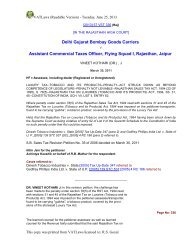


![levy of tax under vat 9b an stamp duty simultaneously[1] - RS Goyal ...](https://img.yumpu.com/45559052/1/158x260/levy-of-tax-under-vat-9b-an-stamp-duty-simultaneously1-rs-goyal-.jpg?quality=85)
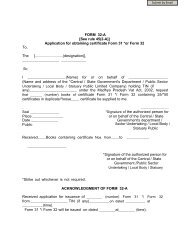
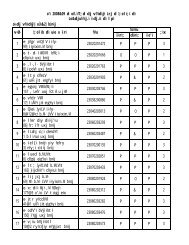
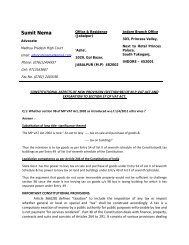
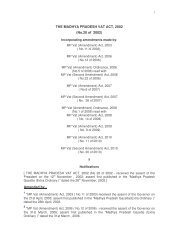


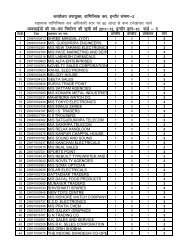
![[2012] 54 VST 26 (P and H) - RS Goyal & Associates](https://img.yumpu.com/38348208/1/190x245/2012-54-vst-26-p-and-h-rs-goyal-associates.jpg?quality=85)

![[2012] 47 vst 116 (cestat) - RS Goyal & Associates](https://img.yumpu.com/38348091/1/190x245/2012-47-vst-116-cestat-rs-goyal-associates.jpg?quality=85)
![[2012] 47 VST 379 (Ker) - RS Goyal & Associates](https://img.yumpu.com/38348087/1/190x245/2012-47-vst-379-ker-rs-goyal-associates.jpg?quality=85)